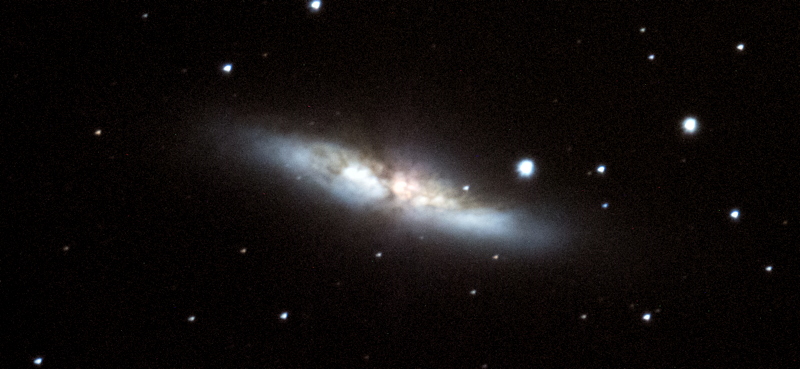Imaging: Moon; Jupiter; M1;
Galaxies M101, M51, M82
Posted: 13 March 2016
Friday, 11 March 2016, dawned with cloudy skies and a forecast for a cloudy night. Saturday dawned cloudy and windy, but with a forecast for a clear night. The sky cleared by mid-morning, although the wind remained strong all day.
|
Open: Saturday, 12 March 2016, 1826 MST Temperature: 68°F |
Session: 933 Conditions: Clear, breezy |
1832 MST: sunset. Turned StarLock OFF. 1842 MST: viewed the Moon, 102X. Seeing not good. Switched to the Baader 8-24mm Zoom Eyepiece. Tried 305X (8mm) but that was too much magnification for the bad seeing. 203X (12mm) worked nicely, yielded some good views at times.
Mounted the D7200 DSLR at 12" LX600 prime focus + visual back. This is a 1/320sec, ISO 400, White Balance Auto, image of the Moon:

Removed the camera and used the zoom eyepiece at 203X for this handheld iPhone 6s Plus afocal image (slightly cropped) of Mare Crisium:

Resumed lunar observing using the zoom eyepiece until 1916 MST. Slewed to Rigel to check component star separation (similar to the Sirius A-B separation), 305X. Then went to Sirius, but was unable to see the "Pup Star", 305X. The poor seeing did not help. 1934 MST: ended attempt.
Slewed to Jupiter, low in the east. Used the zoom eyepiece at various magnifications. The four Galilean Moons. The Great Red Spot was barely visible. Seeing was basically lousy. Switched to the 24mm UWA eyepiece (102X) + 2X PowerMate.
2013 MST: now that it was dark I turned the StarLock ON and added six more pieces of red lens tape to the StarLock status red LED. I had added five layers of the red tape to the LED on 26 February, but after several nights of use that way I decided it needed more. With 11 layers of red lens tape the StarLock LED status light is now sufficiently dimmed down to not be too bright at my dark site.
2105 MST: mounted the DSLR at prime focus + visual back + 2X PowerMate for some Jupiter imaging. Seeing was still not very good. This is a merge of two images (cropped), 1/320sec, ISO 1600, and 1/2sec, ISO 1600, WB Auto, showing Jupiter and the four moons:

I then did a HD video recording, 1.3X crop factor, 60 fps, 1/250sec, ISO 1600, WB Auto, 30 seconds in length. This is a stack of 1839 video frames using Keith's Image Stacker:

The Great Red Spot is visible at the lower right. Seeing was still bad.
Removed the camera and put the 24mm eyepiece on the star diagonal. Did a GOTO M1 (Crab Nebula). Then began waiting until the crescent Moon was less a factor in brightening the sky. 2143 MST: slewed to Betelgeuse, which would be the focus test object using the Astrozap focusing mask. After doing the focus test turned the StarLock ON and did a GOTO M1. No M1 was in the camera viewfinder. Did a GOTO Aldebaran, which was placed slightly off-center in the camera field-of-view (FOV). Centered it and did a SYNC on it. Did a GOTO M1, which was placed near the center of the DSLR FOV. This is a 30 seconds, ISO 12800, White Balance 4000K, image (cropped) of M1 (the Crab Nebula):

Next, did a GOTO M51 (Whirlpool Galaxy). Did some 2 minute exposures. Then went to M101 galaxy and did some 2 minute exposures. Since StarLock autoguiding seemed pretty good I decided to try a test exposure of 5 minutes, ISO 4000, WB 4000K. This was the result (slightly cropped):

Wow! And I haven't yet fine-tuned the StarLock for autoguiding (still waiting for the pier). Went back to M51 (Whirlpool Galaxy) for this 5 minutes, ISO 4000, WB 4000K, image (slightly cropped):

The last galaxy imaged this night was M82, 5 minutes, ISO 4000, WB 4000K:

2303 MST: ended galaxy imaging. Turned the StarLock OFF and went to Jupiter. This stack of 1833 video frames, 1.3X crop, 60 fps, 1/400sec, ISO 1000, WB Auto, was done at prime focus:

2313 MST: ended imaging. Viewed Jupiter, 102X. Seeing was much better now. There were no breezes.
Overall a pretty good 5 hour session with the new 12" LX600 telescope.
|
Close: Saturday, 12 March 2016, 2331 MST Temperature: 45°F |
Session Length: 5h 05m Conditions: Clear |
Comments are welcome using Email. If you are on Twitter you can use the button below to tweet this report to your followers. Thanks.
Cassiopeia Observatory Home Page
Copyright ©2016 Michael L. Weasner / mweasner@me.com
URL = http://www.weasner.com/co/Reports/2016/03/13/index.html
